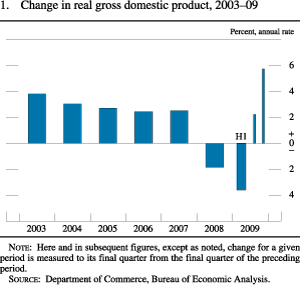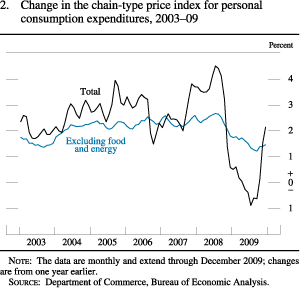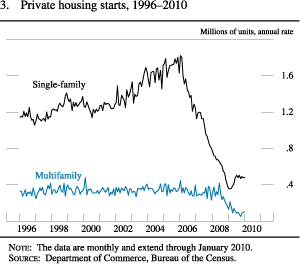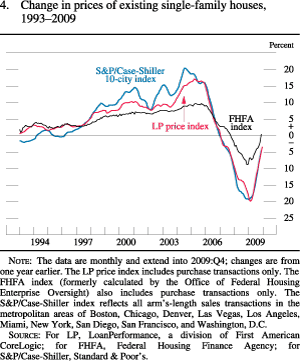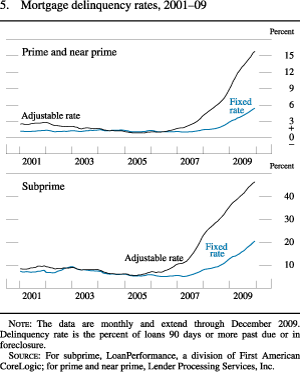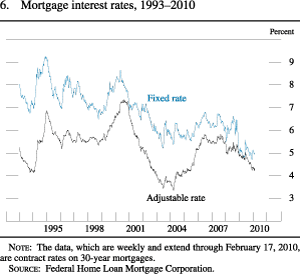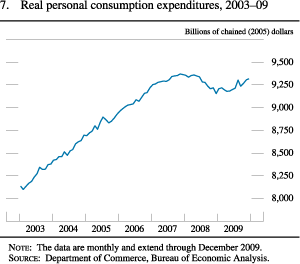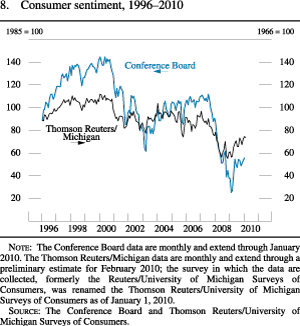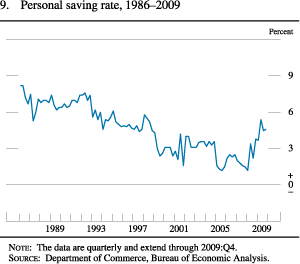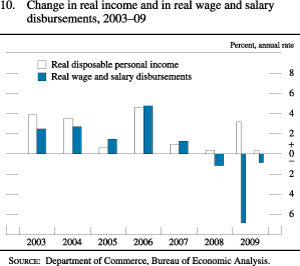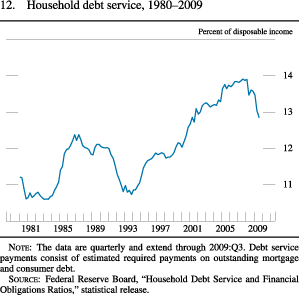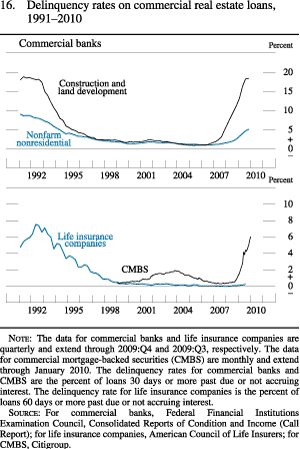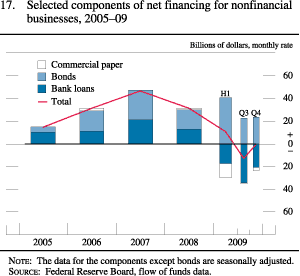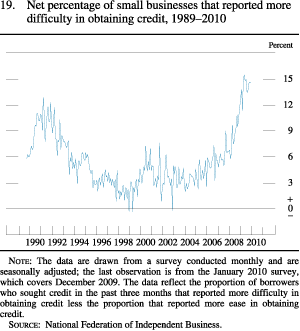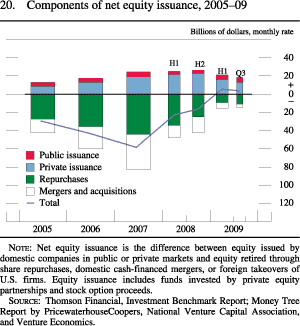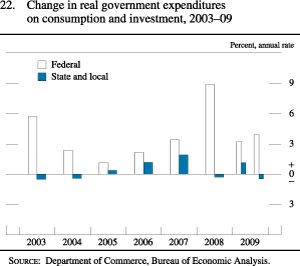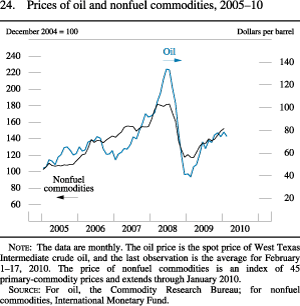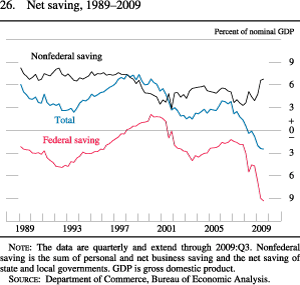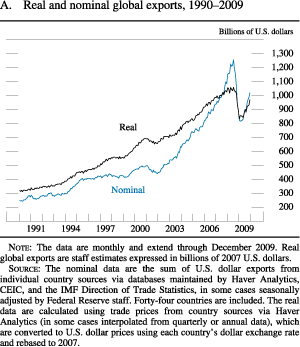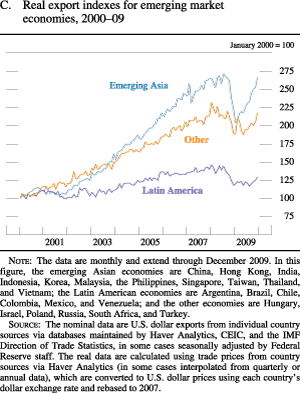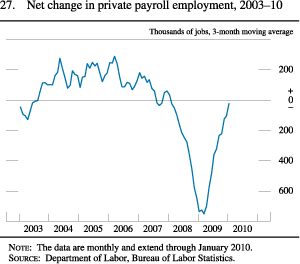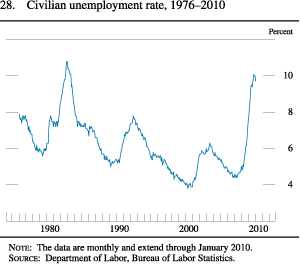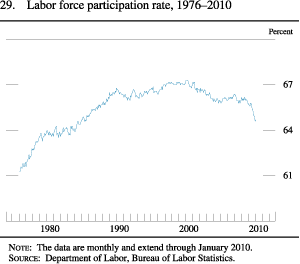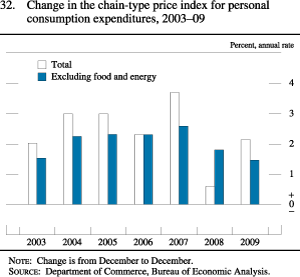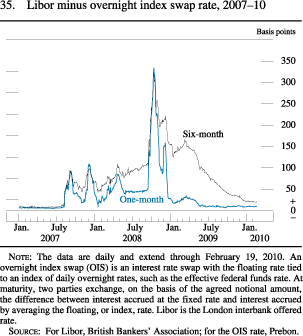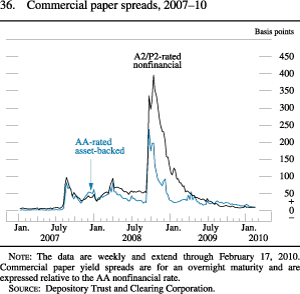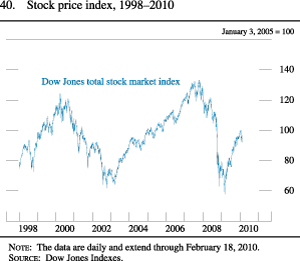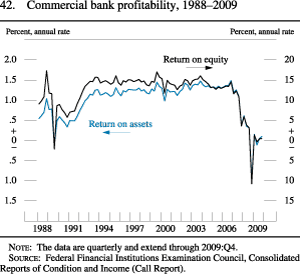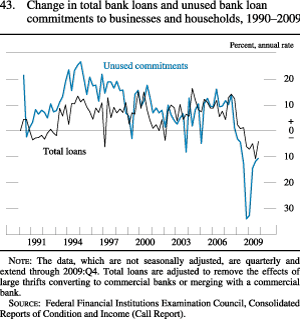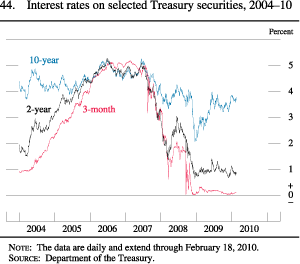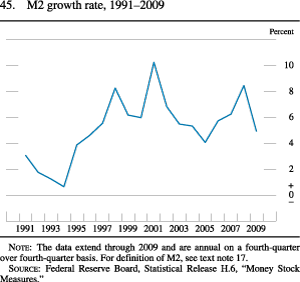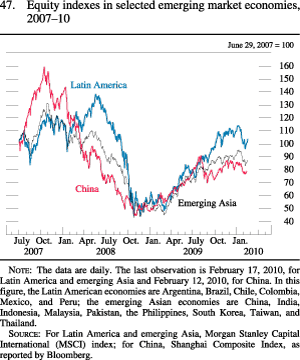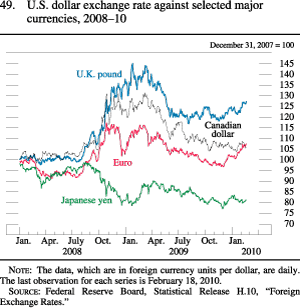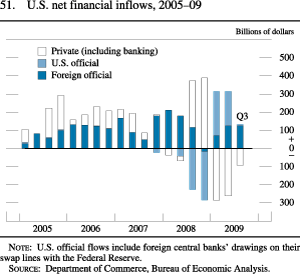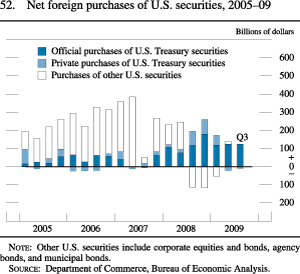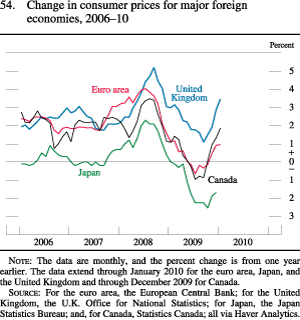- February 24, 2010: Part 1
- Part 2
- Part 3
- Part 4
- Abbreviations
- Printable Version (927 KB PDF)

Sections of Part 2
Part 2: Recent Financial and Economic Developments
Monetary Policy Report submitted to the Congress on February 24, 2010, pursuant to section 2B of the Federal Reserve ActAccording to the advance estimate from the Bureau of Economic Analysis, real gross domestic product (GDP) increased at an annual rate of 4 percent in the second half of 2009, retracing part of the sharp decline in activity that began in early 2008 (figure 1). Nonetheless, labor market conditions, which tend to lag changes in economic activity, remain very weak: The unemployment rate rose to 10 percent at the end of last year, 5 percentage points above its level at the start of 2008, before dropping back some in January. Conditions in many financial markets have improved significantly, but lending policies at banks remain stringent. Meanwhile, an increase in energy prices has boosted overall consumer price inflation; however, price inflation for other items has remained subdued, and inflation expectations have been relatively stable (figure 2).
Conditions in financial markets improved further in the second half of 2009, reflecting a more positive economic outlook as well as the effects of the policy initiatives implemented by the Federal Reserve, the Treasury, and other government agencies to support financial stability and promote economic recovery. Treasury yields, mortgage rates, and other market interest rates remained low while equity prices continued to rise, on net, amid positive earnings news, and corporate bond spreads narrowed substantially. As the functioning of short-term funding markets improved further, the usage of special liquidity facilities declined sharply, and the Federal Reserve closed several of those facilities on February 1, 2010.1 Investors also seemed to become more optimistic about the prospects for the banking sector, and many of the largest banking institutions issued equity and repaid investments made by the Treasury under the Troubled Asset Relief Program (TARP). Nevertheless, the credit quality of bank loan portfolios remained a concern, particularly for loans secured by commercial and residential real estate loans.
Private domestic nonfinancial sector debt contracted, on balance, in the second half of 2009. On the positive side, firms with access to capital markets issued corporate bonds at a robust pace, with many firms reportedly seeking to lock in long-term, low-interest-rate debt or refinance other debt. By contrast, many small businesses and other firms that depend primarily on banks for their funding needs faced substantial constraints on their access to credit even as demand for such credit remained weak. In the household sector, demand for credit was weak, and supply conditions remained tight, as banks maintained stringent lending standards for both consumer loans and residential real estate loans. However, issuance of asset-backed securities (ABS), which are an important source of funding for consumer loans, strengthened, supported in part by the Federal Reserve's Term Asset-Backed Securities Loan Facility (TALF).
Domestic Developments
The Household Sector
Residential Investment and Housing Finance
The housing market began to recover in the spring of 2009, but the pace of improvement slowed during the second half of the year. After having increased almost 30 percent through mid-2009, sales of new single-family homes retraced about one-half of that gain in the second half of the year. And, although sales of existing single-family homes moved up noticeably through November, they fell back sharply in December, suggesting that some of the earlier strength reflected sales that had been pulled forward in anticipation of the expiration of the first-time homebuyer tax credit.2 The index of pending home sales, a leading indicator of sales of existing homes, leveled off in December after November's steep decline.
The recovery in construction activity in the single-family sector also decelerated in the second half of 2009. After stepping up noticeably last spring from an exceptionally low level, starts of single-family homes were about flat, on average, from June to December (figure 3). With the level of construction remaining quite low, the inventory of unsold new homes fell sharply and is now less than one-half of the peak reached in 2006. In the much smaller multifamily sector--where tight credit conditions and high vacancies have depressed building--starts deteriorated a bit further in the second half of the year.
After falling sharply for about two and a half years, house prices, as measured by a number of national indexes, were more stable in the second half of 2009 (figure 4). One house price measure with wide geographic coverage--the LoanPerformance repeat-sales index--is up, on net, from its trough earlier in the year, even though the last few readings of that index fell back a bit. According to the Thomson Reuters/University of Michigan Surveys of Consumers, the number of respondents who expect house prices to increase over the next 12 months has moved up and now slightly exceeds the number of respondents who expect prices to decrease.3 The earlier declines in house prices in combination with the low level of mortgage rates have made housing more affordable, and the apparent stabilization in prices may bring into the market buyers who were reluctant to purchase a home when prices were perceived to be falling. That said, the still-substantial inventory of unsold homes, including foreclosed homes, has continued to weigh on the market.
Even with house prices showing signs of stabilization, home values remained well below the remaining amount of principal on mortgages (so-called underwater loans) for many borrowers in the second half of 2009. Against this backdrop, and with a very high unemployment rate, delinquency rates on all types of residential mortgages continued to move higher (figure 5). As of December, serious delinquency rates on prime and near-prime loans had climbed to 16 percent for variable-rate loans and to over 5 percent for fixed rate loans.4 The delinquency rate on all subprime loans was about 35 percent in December. Loans backed by the Federal Housing Administration (FHA) also showed increasing strains, with delinquency rates moving up to 9 percent at the end of 2009.
Foreclosures remained exceptionally elevated in the second half of 2009. About 1.4 million homes entered foreclosure during that period, similar to the pace earlier in the year. Historically, about one-half of foreclosure starts have resulted in homeowners losing the home. The heightened level of foreclosures has been particularly notable among prime borrowers, for whom the number of foreclosure starts moved up a bit in the second half of the year; by contrast foreclosure starts for subprime borrowers dropped back somewhat. To address the foreclosure problem, the Treasury has intensified efforts through its Making Home Affordable program to encourage loan modifications and to allow borrowers to refinance into mortgages with more-affordable payments.
Interest rates on 30-year fixed-rate conforming mortgages moved down in the second half of 2009, and despite a modest upturn around the start of 2010, they remained near the lowest levels on record (figure 6).5 The low mortgage rates reflected the generally low level of Treasury yields and the large purchases of agency mortgage-backed securities (MBS) by the Federal Reserve, which were reportedly an important factor behind the narrow spread between these conforming mortgage rates and yields on Treasury securities. Interest rates on nonconforming mortgages, which are not included in the mortgage pools backing MBS that are eligible for purchase by the Federal Reserve, also generally declined, but the spreads between nonconforming mortgage rates and rates on conforming mortgages remained wide by historical standards.
Although mortgage rates fell to low levels, the availability of mortgage financing continued to be sharply constrained. Respondents to the Senior Loan Officer Opinion Survey on Bank Lending Practices (SLOOS) indicated throughout 2009 that banks continued to tighten their lending standards for all types of mortgage loans, though smaller net fractions reported doing so in the January 2010 survey than had been the case in earlier surveys. Lenders' reluctance to extend mortgage credit in an environment of declining home values also likely held down refinancing activity, which remained subdued in the second half of 2009 even though mortgage rates decreased. The FHA announced that it was raising mortgage insurance premiums because its capital reserve ratio had fallen below the required threshold; at the same time, the FHA announced that it was increasing down-payment requirements for borrowers with very low credit scores. In recent years, the FHA has assumed a greater role in mortgage markets, especially for borrowers with high loan-to-value ratios or lower credit quality. Overall, residential mortgage debt outstanding contracted at an even faster pace in the second half than in the first half of the year. Net issuance of MBS by Fannie Mae, Freddie Mac, and Ginnie Mae, although brisk in the second half of 2009, was down a bit from the levels seen earlier in the year. The securitization market for mortgage loans not guaranteed by a housing-related government-sponsored enterprise (GSE) or the FHA remained closed.
Consumer Spending and Household Finance
After having been roughly constant in the first half of last year, real personal consumption expenditures (PCE) rose at an annual rate of about 2-1/2 percent in the second half (figure 7). Sales of new light motor vehicles jumped from an average annual rate of 9-1/2 million units in the first half of 2009 to a rate of 11-1/4 million units in the second half.6 Part of this rebound likely reflected the "cash for clunkers" program, but even after the expiration of that program, sales remained close to 11 million units, supported in part by improved credit conditions for auto buyers as the ABS market revived. Real spending on goods excluding motor vehicles also increased at a robust pace in the second half of the year, while real outlays for services rose more modestly.
The rise in consumer spending in 2009 was buoyed by improvements in some of its underlying determinants: Equity prices moved up from their lows reached last March, a development that helped to rebuild household wealth, and household income was lifted by provisions in the fiscal stimulus package. Accordingly, consumer sentiment has rebounded from the very low levels seen earlier in 2009, though it remains low by historical standards (figure 8). Consumer spending appears to have been financed largely out of current income over the past year, and households were also able to increase their personal saving and begin deleveraging their balance sheets. After increasing sharply in 2008, the saving rate moved up a bit further in 2009 (figure 9).
Real disposable personal income--after-tax income adjusted for inflation--increased about 1-3/4 percent last year, with the effects of the tax cuts and higher social benefit payments included in the 2009 fiscal stimulus package accounting for most of the increase.7 Real labor income--that is, total wages, salaries, and employee benefits, adjusted for inflation--fell sharply in the first half of the 2009, and edged down a bit further in the second half, as the decline in total employee work hours more than offset an increase in real hourly compensation (figure 10).
After dropping during the preceding 2-1/2 years, household net worth turned up in the second and third quarters of 2009 and likely rose further in the fourth quarter. Much of the recovery reflected a rebound in equity prices, although the modest gain, on net, in the value of owner-occupied real estate also contributed. With the rise in net worth, the ratio of household wealth to disposable income increased in the second half of the year to about its historical average (figure 11).
Households began to deleverage around the third quarter of 2008, at the height of the financial crisis, and that process continued during the second half of 2009. The decline in nonmortgage consumer debt intensified during the latter part of last year. The contraction was most pronounced in revolving credit, which fell at about a 10 percent annual rate during the second half of 2009. Nonrevolving credit also decreased. Including the drop in mortgage debt, the Federal Reserve's flow of funds data indicate that total household debt declined in 2009 for the first time since the data series began in 1951. Reflecting these developments, debt service payments--the required principal and interest on existing mortgages and consumer debt--fell as a share of disposable income. At the end of the third quarter, the ratio of debt service payments to disposable income had declined to its lowest level since 2001 (figure 12).
Results from the recent SLOOS suggest that the contraction in consumer credit has been the result of both weak demand and tight supply. A net fraction of about one-third of the bank loan officers that responded to the January SLOOS reported weaker demand for all types of consumer loans. The same survey also indicated that banks continued to tighten terms on credit card loans over the final three months of 2009 by reducing credit limits and raising interest rates charged, though smaller net fractions reported doing so than in previous surveys. After having been tightened significantly in the summer and fall of 2009, standards and terms on consumer loans other than credit card loans were little changed, on balance, in the January survey.
Changes in interest rates on consumer loans were mixed during the second half of 2009. Interest rates on new auto loans generally continued to trend lower, and spreads on these loans relative to comparable-maturity Treasury securities narrowed further. Interest rates on credit card loans, however, jumped near midyear and increased further toward year-end. According to the October SLOOS, some of the increases in credit card interest rates and the tightening of other lending terms reflected adjustments made by banks in anticipation of the imposition of new rules under the Credit Card Accountability Responsibility and Disclosure (Credit CARD) Act.8
Concerns about the ability of households to repay loans may also have contributed to the tightening of lending policies for consumer credit over the second half of 2009. Delinquency rates on auto loans at captive finance companies remained elevated, and credit card delinquency rates at commercial banks stayed high at around 6-1/2 percent in the fourth quarter of 2009. In addition, the pace at which lenders were charging off these loans increased sharply in recent quarters. On a more positive note, respondents to the January SLOOS indicated that they expected the credit quality of their consumer loans, other than credit card loans, to stabilize during 2010.
Prior to the crisis, a large portion of consumer credit was funded through the ABS market. After having essentially ground to a halt at the end of 2008, consumer ABS markets recovered in 2009 with the important support of the TALF (figure 13). Much of the ABS issuance through the summer relied heavily on the TALF for financing. By the end of the year, the yields on such securities dropped markedly, and issuance of ABS without TALF support increased accordingly. (Indeed, the interest rates on TALF loans were chosen so that they would become unattractive as market conditions improved.) Issuance of ABS backed by auto loans in the second half of 2009 was roughly on par with issuance prior to the financial crisis, and only a small portion was purchased using loans from the TALF. A renewed ability to securitize auto loans may have contributed to the reduction in the interest rates on these loans. Similarly, ABS issuance backed by credit card receivables gained strength through most of the year, though it experienced a drop early in the fourth quarter because of uncertainty about how the Federal Deposit Insurance Corporation (FDIC) would treat securitized receivables should a sponsoring bank fail. Issuance picked up slightly after the FDIC provided a temporary extension of safe-harbor rules for its handling of securitized assets in a receivership. By contrast, issuance of ABS backed by private student loans remained almost entirely dependent on financing from the TALF.

Accessible Version of Figure 13
The Business Sector
Fixed Investment
After falling throughout 2008 and the first half of 2009, business spending on equipment and software (E&S) began to expand in the second half of last year, as sales prospects picked up, corporate profits increased, and financial conditions for many businesses (especially those with direct access to capital markets) improved (figure 14). Business outlays on transportation equipment rose sharply in the second half as firms rebuilt their fleets of light motor vehicles and accelerated their purchases of large trucks in advance of new environmental regulations on diesel engines. Real spending on information technology capital--computers, software, and communications equipment--also accelerated toward the end of 2009, likely boosted by the desire to replace older, less-efficient equipment. Investment in equipment other than information processing and transportation, which accounts for nearly one-half of E&S outlays, continued to fall during the second half of 2009, but much more slowly than earlier in the year. More recently, orders of nondefense capital goods other than transportation items posted a second strong monthly increase in December, and recent surveys of business conditions have been more upbeat than in several years.
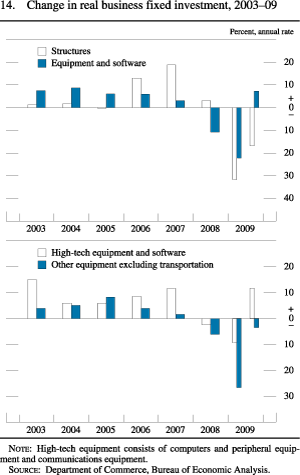
Accessible Version of Figure 14
In contrast to the upturn in equipment investment, real spending on nonresidential structures continued to decline steeply throughout 2009. Real outlays for construction of structures other than those used for drilling and mining fell at an annual rate of 25 percent in the second half of 2009, likely reflecting the drag from rising vacancy rates and plunging property prices for commercial and office buildings, as well as difficult financing conditions for new projects. Following a steep drop in the first half of the year, real spending on drilling and mining structures increased sharply in the second half, likely in response to the rebound in oil prices.
Inventory Investment
After running off inventories aggressively during the first three quarters of 2009, firms moved to stem the pace of liquidation in the fourth quarter (figure 15). Automakers added to their dealers' stocks after cutbacks in production earlier in the year had reduced days' supply of domestic light vehicles to below their preferred levels. Outside of motor vehicles, firms continued to draw down inventories in the fourth quarter, but at a much slower pace than earlier in the year. Indeed, purchasing managers in the manufacturing sector report that their customers' inventories are relatively lean, a development that could lead to some restocking in the coming months.
Corporate Profits and Business Finance
Overall, operating earnings per share for S&P 500 firms rebounded over the course of 2009. Still, earnings were well below the levels experienced prior to the financial market turmoil and the accompanying recession. Within the S&P 500, earnings for financial firms fluctuated around low levels, while earnings for nonfinancial firms rebounded sharply as the economic recovery began to take hold. Data from firms that have reported for the fourth quarter suggest that earnings for nonfinancial firms continued to recover.
The credit quality of nonfinancial corporations improved somewhat over the second part of last year, although signs of stress persisted. Business leverage, as measured by the ratio of debt to assets, fell in the third quarter. Credit rating downgrades outpaced upgrades early in 2009, but the pace of downgrades moderated substantially in the second half of the year, and by the fourth quarter upgrades were outpacing downgrades. In addition, the corporate bond default rate dropped into the range that had prevailed before the financial crisis began in August 2007.
Delinquency rates on loans to nonfinancial businesses, however, rose throughout the year. For commercial and industrial (C&I) loans, delinquencies in the fourth quarter reached 4.5 percent. In response to a special question on the January 2010 SLOOS, a large net fraction of banks reported that in the fourth quarter, the credit quality of their existing C&I loans to small firms was worse than the quality of their loans to larger firms. While survey respondents generally expected the credit quality of their C&I loan portfolios to improve during 2010, banks' outlook for C&I loans to larger firms was more optimistic than it was for such loans to smaller firms. Reflecting deterioration in commercial property markets, delinquency rates on commercial real estate (CRE) loans both in securitized pools and on banks' books moved up sharply in the second half of 2009 (figure 16). Delinquency rates on construction and land development loans climbed to especially high levels. In October 2009, the Federal Reserve joined with other banking regulators to provide guidelines to banks in their efforts to work constructively with troubled CRE borrowers.9
The debt of domestic nonfinancial businesses contracted slightly during the second half of 2009, and the composition of borrowing continued to shift toward longer-term debt (figure 17). Net issuance of corporate bonds remained strong as businesses took advantage of favorable market conditions to issue longer-term debt; at the same time, bank loans to businesses--both C&I and CRE loans--contracted, as did commercial paper.
The decline in bank lending to businesses was due partly to the weakness in loan demand. Many banks experiencing steep declines in C&I loans reported that existing loans were paid down across a wide swath of industries. Respondents to the January 2010 SLOOS indicated that weak demand for C&I loans during the second half of 2009 reflected their customers' reduced need to use these loans to finance investment in plant and equipment as well as to finance accounts receivable, inventories, and mergers and acquisitions. In addition, demand was reportedly low for CRE loans amid weak fundamentals in the sector.
The weakness in bank lending to businesses in 2009 was also a consequence of a tightening in lending standards. Responses to the SLOOS indicated that lending standards for C&I loans were tightened significantly in the summer and fall of 2009 and that they remained about unchanged in the final months of the year (figure 18). In addition, many banks continued to tighten some terms throughout the year--for example, by increasing the interest rate premiums charged on riskier loans. Considerable net fractions of banks also continued to report tightening lending standards on CRE loans.
Small businesses have been particularly affected by tight bank lending standards because of their lack of direct access to capital markets. In surveys conducted by the National Federation of Independent Business (NFIB), the net fraction of small businesses reporting that credit had become more difficult to obtain over the preceding three months remained at extremely elevated levels during the second half of 2009 (figure 19). Moreover, considerable net fractions of NFIB survey respondents expected lending conditions to tighten further in the near term. However, when asked about the most important problem they faced, small businesses most frequently cited poor sales, while only a small fraction cited credit availability. Recognizing that small businesses play a crucial role in the economy and that some are experiencing difficulty in obtaining or renewing credit, the federal financial regulatory agencies and the Conference of State Bank Supervisors issued a statement on February 5, 2010, regarding lending to these businesses.10 The statement emphasized that financial institutions that engage in prudent small business lending will not be subject to supervisory criticism for small business loans made on that basis. Further, the statement emphasized that regulators are working with the industry and supervisory staff to ensure that supervisory policies and actions do not inadvertently curtail the availability of credit to financially sound small business borrowers.
In the equity market, both seasoned and initial offerings by nonfinancial firms were solid in the second half of 2009 (figure 20). After nearly ceasing earlier in the year, cash-financed mergers picked up toward year-end, mostly as the result of a few large deals. Share repurchases continued to be light.
New issuance in the commercial mortgage-backed securities (CMBS) market--which had ceased in the third quarter of 2008, thus eliminating an important source of financing for many lenders--resumed in November 2009 with a securitization supported by the Federal Reserve's TALF program. A handful of subsequent small securitizations, with more-conservative underwriting and simpler structures than had prevailed during the credit boom, were brought to market and successfully completed without support from the TALF. Nevertheless, issuance of CMBS remains very light, and material increases in issuance appeared unlikely in the near term. Trading in existing CMBS picked up during the second half of 2009, and yield spreads relative to Treasury securities narrowed, although they remain very high by historical standards. Some of the improvement likely reflected support provided by the Federal Reserve through the part of the TALF program that provides loans for the purchase of "legacy" CMBS.
Issuance of leveraged loans, which often involves loan extensions by nonbank financial institutions, also remained weak throughout 2009 although market conditions reportedly improved. Prior to the crisis, this segment of the syndicated loan market provided considerable financing to lower-rated nonfinancial firms. However, issuance of leveraged loans fell to low levels when investors moved away from structured finance products such as collateralized loan obligations, which had been substantial purchasers of such credits. The market began to show signs of recovery last year with secondary-market prices of loans moving higher, and, by late in the year, new loans had found increased investor interest amid some easing in loan terms.
The Government Sector
Federal Government
The deficit in the federal unified budget rose markedly in fiscal year 2009 and reached $1.4 trillion, about $1 trillion higher than in fiscal 2008. The effects of the weak economy on revenues and outlays, along with the budget costs associated with the fiscal stimulus legislation enacted last February (the American Recovery and Reinvestment Act (ARRA)), the Troubled Asset Relief Program, and the conservatorship of the mortgage-related GSEs, all contributed to the widening of the budget gap. The deficit is expected to remain sharply elevated in fiscal 2010. Although the budget costs of the financial stabilization programs are expected to be lower than in the last fiscal year, the spend-out from last year's fiscal stimulus package is expected to be higher, and tax revenues are anticipated to remain weak. The Congressional Budget Office projects that the deficit will be about $1.3 trillion this fiscal year, just a touch below last year's deficit, and that federal debt held by the public will reach 60 percent of nominal GDP, the highest level recorded since the early 1950s.
The steep drop in economic activity during 2008 and the first half of 2009 resulted in sharply lower tax receipts (figure 21). After falling about 2 percent in fiscal 2008, federal receipts plunged 18 percent in fiscal 2009, and tax receipts over the first four months of the current fiscal year have continued to decline relative to the comparable year-earlier period. The decline in revenues in fiscal 2009 was particularly steep for corporate taxes, mostly as a result of the sharp contraction in corporate profits in 2008.11 Individual income and payroll taxes also declined substantially, reflecting the effects of the weak labor market on nominal wage and salary income, a decline in capital gains realizations, and the revenue-reducing provisions of the 2009 fiscal stimulus legislation.
While the outlays associated with the TARP and the conservatorship of the GSEs contributed importantly to the rapid rise in federal spending in fiscal 2009, outlays excluding these extraordinary costs rose a relatively steep 10 percent.12 Spending for Medicaid and income support programs jumped almost 25 percent in fiscal 2009 as a result of the deterioration in the labor market as well as policy decisions to expand funding for a number of such programs. This category of spending has continued to rise rapidly thus far in fiscal 2010, and most other categories of spending have increased fairly briskly as well.
As measured in the national income and product accounts (NIPA), real federal expenditures on consumption and gross investment--the part of federal spending that is a direct component of GDP--rose at a 4 percent pace in the second half of 2009 (figure 22). Nondefense outlays increased rapidly, in part reflecting the boost in spending from the 2009 fiscal stimulus legislation, while real defense outlays rose modestly.
Federal Borrowing
Federal debt expanded rapidly throughout 2009 and rose to more than 50 percent of nominal GDP by the end of 2009, up from around 35 percent earlier in the decade. To fund the increased borrowing needs, Treasury auctions grew to record sizes. However, demand for Treasury issues kept pace, and bid-to-cover ratios at these auctions were generally strong. Foreign demand was solid, and foreign custody holdings of Treasury securities at the Federal Reserve Bank of New York increased considerably over the year.
State and Local Government
Despite the substantial federal aid provided by the ARRA, the fiscal situations of state and local governments remain challenging. At the state level, revenues from income, business, and sales taxes continued to fall in the second half of last year, and many states are currently in the process of addressing shortfalls in their fiscal 2010 budgets. At the local level, revenues have held up fairly well, as receipts from property taxes, on which these jurisdictions rely heavily, have continued to rise moderately, reflecting the typically slow response of property assessments to changes in home values. Nevertheless, the sharp fall in house prices over the past few years is likely to put some downward pressure on local revenues before long. Moreover, many state and local governments have experienced significant capital losses in their employee pension funds, and they will need to set aside resources in coming years to rebuild pension assets.
These budget pressures showed through to state and local spending. As measured in the NIPA, real consumption expenditures of state and local governments declined over the second half of 2009.13 In particular, these jurisdictions began to reduce employment in mid-2009, and those cuts continued in January. In contrast, investment spending by state and local governments rose moderately during the second half of 2009. The rise in investment spending was supported by infrastructure grants provided by the federal government as part of the ARRA, as well as by a recovery of activity in municipal bond markets that increased the availability and lowered the cost of financing. Also, because capital budgets are typically not encompassed within balanced budget requirements, states were under less pressure to restrain their investment spending.
State and Local Government Borrowing
Borrowing by state and local governments picked up a bit in the second half of the year from its already solid pace in the first half. Gross issuance of long-term bonds, primarily to finance new capital projects, was strong. Issuance was supported by the Build America Bonds program, which was authorized under the ARRA.14 Short-term issuance was more moderate and generally consistent with typical seasonal patterns. Market participants reported that the market for variable-rate demand obligations, which became severely strained during the financial crisis, had largely recovered.15
Interest rates on long-term municipal bonds declined during the year, but the ratio of their yields to those on comparable-maturity Treasury securities remained somewhat elevated by historical standards. Credit ratings of state and local governments deteriorated over 2009 as a consequence of budgetary problems faced by many of these governments.
The External Sector
Both exports and imports rebounded in the second half of 2009 from precipitous falls earlier in the year (figure 23). As foreign economic activity began to improve, real exports rose at an annual rate of nearly 20 percent in the second half of the year. Real imports increased at about the same pace, supported by the recovery under way in U.S. demand. The pickup in trade flows was widespread across major types of products and U.S. trading partners but was particularly pronounced for both exports and imports of capital goods. Exports and imports of automotive products also picked up sharply in the second half of last year, reflecting the rise in motor vehicle production in North America, which depends importantly on flows of parts and finished vehicles between the United States, Canada, and Mexico. Despite the bounceback, trade flows only partially retraced the unusually steep declines registered in late 2008 and early 2009. This pattern was also true for global trade flows, as discussed in the box "Developments in Global Trade." The strength of the recovery in global trade so far, however, differs substantially across countries and regions.
Oil and nonfuel commodity prices increased substantially over the year (figure 24). After plunging from a daily high of about $145 per barrel in mid-2008 to a low of less than $40 per barrel early in 2009, the spot price of West Texas Intermediate crude oil rose rapidly to reach about $70 per barrel by the middle of 2009. The price of oil rose further over the second half of the year to reach about $80 per barrel in November and has fluctuated between $70 and $80 per barrel through mid-February 2010. The increase in the price of oil over the course of 2009 was driven in large measure by strengthening global activity, particularly in the emerging market economies. The ongoing effects of earlier restrictions in OPEC supply were another likely contributing factor. The prices of longer-term futures contracts (that is, those expiring in December 2018) for crude oil also moved up and, as of mid-February, were about $96 per barrel. The upward-sloping futures curve is consistent with a view by market participants that oil prices will continue to rise as global demand strengthens over the medium term.
Broad indexes of nonfuel commodity prices also rose from lows near the start of 2009. As with the rise in oil prices, a key driver of the increase in commodity prices has been resurgent demand from emerging market economies, especially China. Market participants expect some further increases in commodity prices as the economic recovery gains strength, albeit increases that are less pronounced than those recorded during last year's rebound.
The steep decline in commodity prices in late 2008 put considerable downward pressure on U.S. import prices for the first half of 2009. Overall for 2009, prices of imported goods fell 1 percent while prices for goods excluding oil fell 2-1/2 percent. Recent upward moves in commodity prices suggest that some of this downward pressure on import prices will be reversed in 2010.
The U.S. trade deficit narrowed considerably in the first half of 2009. Nominal imports fell more than nominal exports early in the year, partly reflecting a substantial decline in the value of oil imports. The trade deficit widened moderately over the remainder of the year, however, as both imports and exports picked up in subsequent quarters and oil prices moved higher. In the fourth quarter of 2009, the trade deficit was $440 billion (annual rate), or about 3 percent of nominal GDP, compared with a deficit of 4 percent of nominal GDP a year earlier (figure 25).
National Saving
Total U.S. net national saving--that is, the saving of households, businesses, and governments, excluding depreciation charges--remained extremely low by historical standards in 2009, averaging about negative 2-1/2 percent of nominal GDP over the first three quarters of the year (figure 26). After having reached nearly 4 percent of nominal GDP in early 2006, net national saving dropped over the subsequent three years as the federal budget deficit widened substantially and the fiscal positions of state and local governments deteriorated. In contrast, private saving rose considerably, on balance, over this period. National saving will likely remain relatively low this year in light of the continuing high federal budget deficit. If not raised over the longer run, persistent low levels of national saving will likely be associated with both low rates of capital formation and heavy borrowing from abroad, limiting the rise in the standard of living of U.S. residents over time.
Developments in Global Trade
The downturn in global activity was accompanied by a dramatic collapse in global trade. Measured in U.S. dollars, global exports fell about 35 percent between July 2008 and February 2009.1 About one-third of the decline was a result of falling prices, notably for oil and other commodities. The volume of global exports is estimated to have contracted about 20 percent between mid-2008 and early 2009, a larger and more abrupt decline than has been observed in previous cycles (figure A).
The fall in global exports was also more widespread across countries and regions than has typically been the case in past recessions. The severity of the decline in trade was a major factor in the spread of the economic downturn to the emerging market economies in Asia and Latin America, which were generally less directly exposed to the financial crisis than were the advanced economies. Early on, financial and economic indicators in the emerging market economies appeared to be relatively resilient, raising the possibility that those economies had "decoupled" from developments in the advanced economies. However, the trade channel proved quite potent, and most of the emerging market economies experienced deep recessions. A major exception was China, which provided considerable fiscal stimulus to its own economy.
The primary explanation for the deep and abrupt collapse in global trade seems to be that the contraction in global demand was much more severe than in the past. Constraints on the supply of trade finance related to the general credit crunch may have played a role at the beginning, but the fall in demand soon became the more important factor. The sensitivity of trade to the decline in gross domestic product also appears to have been stronger in this cycle than in past cycles, although there is no real agreement on why this might be the case. Greater integration of production across countries and an increase in exports of products for which there are shorter lags between changes in demand and changes in exports--such as electronics--may also have added to the speed and synchronicity of the collapse.
Exports appear to have stopped declining in most economies in the first half of 2009, but so far the strength of the recovery in trade has differed across countries. In particular, exports of the emerging Asian economies are much closer to their previous peaks than are exports of the advanced economies (figures B and C), as the strength of the Chinese economy has so far been a key factor driving exports of the other emerging Asian economies.
1. The total includes 44 countries. The emerging Asian economies consist of China, Hong Kong, India, Indonesia, Korea, Malaysia, the Philippines, Singapore, Taiwan, Thailand, and Vietnam; the Latin American economies consist of Argentina, Brazil, Chile, Colombia, Mexico, and Venezuela; the other emerging market economies consist of Hungary, Israel, Poland, Russia, South Africa, and Turkey; and the advanced economies consist of Australia, Austria, Belgium, Canada, Denmark, Finland, France, Germany, Greece, Ireland, Italy, Japan, Luxembourg, the Netherlands, Norway, Portugal, Spain, Sweden, Switzerland, the United Kingdom, and the United States. Return to text
The Labor Market
Employment and Unemployment
After falling sharply in the first half of 2009, employment continued to contract through the remainder of the year, but at a gradually moderating pace. Nonfarm private payroll employment fell 725,000 jobs per month, on average, from January to April of 2009; the pace of job loss slowed to about 300,000 per month from May to October, and to an average of 20,000 jobs per month from November to January (figure 27). The moderation in the pace of job losses was relatively widespread across sectors, although cutbacks in employment in the construction industry continued to be sizable through January.
After rising rapidly for more than a year, the unemployment rate stabilized at 10 percent in the fourth quarter of 2009 (figure 28). In January, the jobless rate dropped to 9.7 percent, though it remained 4.7 percentage points higher than its level two years ago.
The slowing in net job losses since mid-2009 primarily reflected a reduction in layoffs rather than an improvement in hiring. Both the number of new job losses and initial claims for unemployment insurance are down significantly from their highs in the spring of 2009, while most indicators of hiring conditions, such as the Bureau of Labor Statistics survey of job openings, remain weak. The average duration of an ongoing spell of unemployment continued to lengthen markedly in the second half of 2009, and joblessness became increasingly concentrated among the long-term unemployed. In January, 6.3 million individuals--more than 40 percent of the unemployed--had been out of work for at least six months. Furthermore, the labor force participation rate has declined steeply since last spring, a development likely related, at least in part, to the reactions of potential workers to the scarcity of employment opportunities (figure 29).
However, in recent months, labor market reports have included some encouraging signs that labor demand may be firming. For example, employment in the temporary help industry, which frequently is one of the first to see an improvement in hiring, has been increasing since October. In addition, after steep declines in 2008 and the first quarter of 2009, the average workweek of production and nonsupervisory employees stabilized at roughly 33.1 hours per week through the remainder of the year, before ticking up to 33.2 hours in November and December and 33.3 hours in January. Another indicator of an improvement in work hours, the fraction of workers on part-time schedules for economic reasons, increased only slightly, on net, in the second half of the year after a sharp rise in the first half and then turned down noticeably in January.
Productivity and Labor Compensation
Labor productivity surged in 2009, reflecting, at least to some extent, the reluctance of firms to increase hiring even as demand expanded. According to the latest available published data, output per hour in the nonfarm business sector increased at an annual rate of 6-3/4 percent in the second half of 2009, after rising 3-1/2 percent in the first half, and about 1 percent in 2008 (figure 30).
Despite large gains in productivity, increases in hourly worker compensation have remained subdued. The employment cost index for private industry workers, which measures both wages and the cost to employers of providing benefits, rose only 1-1/4 percent in nominal terms in 2009 after rising almost 2-1/2 percent in 2008. Compensation per hour in the nonfarm business sector--a measure derived from the worker compensation data in the NIPA--showed less deceleration, rising 2.2 percent in nominal terms in 2009, only slightly slower than the 2.6 percent rise recorded for 2008 (figure 31). Real hourly compensation--that is, adjusted for the rise in consumer prices--increased only modestly. Reflecting the subdued increase in nominal hourly compensation, along with the outsized gain in labor productivity noted earlier, unit labor costs in the nonfarm business sector declined 2-3/4 percent in 2009.
Prices
Headline consumer price inflation picked up in 2009, as sharp increases in energy prices offset reductions in food prices and a deceleration in other prices. After rising 1/2 percent over the 12 months of 2008, overall prices for personal consumption expenditures rose about 2 percent in 2009. In contrast, the core PCE price index--which excludes the prices of energy items as well as those of food and beverages--increased a little less than 1-1/2 percent in 2009, compared with a rise of roughly 1-3/4 percent in 2008 (figure 32). Data for PCE prices in January 2010 are not yet available, but information from the consumer price index and other sources suggests that inflation remained subdued.
Consumer energy prices rose sharply in 2009, reversing much of the steep decline recorded in 2008. The retail price of gasoline was up more than 60 percent for the year as a whole, driven higher by a resurgence in the cost of crude oil. Reflecting the burgeoning supplies from new domestic wells, consumer natural gas prices fell sharply over the first half of 2009, before increasing again in the last few months of the year as the economic outlook improved. Electricity prices also fell during the early part of 2009 before retracing part of that decline later in the year. Overall, natural gas prices were down almost 20 percent in 2009, while electricity prices were about unchanged.
After posting sizable declines throughout much of 2009, food prices turned up modestly in the fourth quarter of last year. For the year as a whole, consumer food prices fell 1-1/2 percent after rising 6-3/4 percent in 2008; these changes largely reflected the pass-through to retail of huge swings in spot prices of crops and livestock over the past two years.
Excluding food and energy, PCE price inflation slowed last year. Core PCE prices rose at an annual rate of 1-3/4 percent in the first half of 2009, similar to the pace in 2008, and then increased at an annual rate of only a little above 1 percent over the final six months of the year. This slowdown in core inflation was centered in a noticeable deceleration in the prices of non-energy services. For those prices, firms' widespread cost-cutting efforts over the past year and the continued weakness in the housing market that has put downward pressure on housing costs have likely been important factors. The prices of many core consumer goods continued to rise only moderately in 2009; a notable exception was tobacco, for which tax-induced price hikes were substantial.
Survey-based measures of near-term inflation expectations, which were unusually low in the beginning of 2009, moved up, on average, over the remainder of the year. According to the Thomson Reuters/University of Michigan Surveys of Consumers, median expectations for year-ahead inflation stood at 2.8 percent in January, up from about 2 percent at the beginning of 2009. Historically, this short-term measure has been influenced fairly heavily by contemporaneous movements in energy prices. Longer-term inflation expectations, by contrast, have been relatively stable over the past year. For example, the Thomson Reuters/University of Michigan survey measure of median 5- to 10-year inflation expectations was 2.9 percent in January of this year, similar to the readings during most of 2009, and near the lower end of the narrow range that has prevailed over the past few years.
Financial Stability Developments
Evolution of the Financial Sector, Policy Actions, and Market Developments
The recovery in the financial sector that began in the first half of 2009 continued through the second half of the year and into 2010, as investor concerns about the health of large financial institutions subsided further. Credit default swap (CDS) spreads for banking institutions--which primarily reflect investors' assessments of and willingness to bear the risk that those institutions will default on their debt obligations--fell considerably from their peaks early in 2009, although they remain above pre-crisis levels (figure 33). Bank equity prices have increased significantly since spring 2009 (figure 34). Many of the largest bank holding companies were able to issue equity and repurchase preferred shares that had been issued to the Treasury under the TARP. Nonetheless, conditions in many banking markets remain very challenging, with delinquency and charge-off rates still elevated, especially on commercial and residential real estate loans. Investor concerns about insurance companies--which had come under pressure in early 2009 and a few of which had received capital injections from the Treasury--also diminished, as indicated by narrowing CDS spreads for those firms and increases in their equity prices. In December, the Treasury announced that it was amending the cap on its Preferred Stock Purchase Agreements with Fannie Mae and Freddie Mac to ensure that each firm would maintain positive net worth for the next three years, and it also announced that it was providing additional capital to GMAC under the TARP.
Consistent with diminishing concerns about the conditions of banking institutions, functioning in bank funding markets has improved steadily since the spring of last year. A measure of stress in these markets--the spread between the London interbank offered rate (Libor) and the rate on comparable-maturity overnight index swaps (OIS)--narrowed at all maturities; spreads at shorter maturities reached pre-crisis levels, while those at longer maturities remained somewhat elevated by historical standards (figure 35). Liquidity in term bank funding markets also improved at terms up to six months. Conditions improved in other money markets as well. Bid-asked spreads and haircuts applied to collateral in repurchase agreement (repo) markets retraced some of the run-ups that had occurred during the financial market turmoil, though haircuts on most types of collateral continued to be sizable relative to pre-crisis levels. In the commercial paper market, spreads between rates on lower-quality A2/P2 paper and on asset-backed commercial paper over higher-quality AA nonfinancial paper fell to the low end of the range observed since the fall of 2007 (figure 36).
With improved conditions in financial markets, the Federal Reserve and other agencies removed some of the extraordinary support that had been provided during the crisis. Starting in the second half of 2009, the Federal Reserve began to normalize its lending to commercial banks. The amounts and maturity of credit auctioned through the Term Auction Facility (TAF) were reduced over time, and early in 2010 the Federal Reserve announced that the final TAF auction would be conducted in March 2010. Later, the Federal Reserve noted that the minimum bid rate for the final auction would be 50 basis points, 1/4 percentage point higher than in recent auctions. The Federal Reserve also shortened the maximum maturity of loans provided under the primary credit program from 90 days to 28 days, effective on January 14, and announced a further reduction of the maximum maturity of those loans to overnight effective March 18. In addition, the rate charged on primary credit loans was increased from 1/2 percent to 3/4 percent effective February 19. Amounts outstanding under many of the Federal Reserve's special liquidity facilities had dwindled to zero (or near zero) over the second half of 2009 as functioning of funding markets, both in the United States and abroad, continued to normalize. The Primary Dealer Credit Facility, the Term Securities Lending Facility, the Commercial Paper Funding Facility, the Asset-Backed Commercial Paper Money Market Mutual Fund Liquidity Facility, and the temporary liquidity swap lines with foreign central banks were all allowed to expire on February 1, 2010. Other government agencies also reduced their support to financial institutions. For instance, to buttress the liquidity of financial institutions, the FDIC had established in October 2008 a program to provide, in exchange for a fee, a guarantee on short- and medium-term debt issued by banking institutions. Financial institutions issued about $300 billion under this program, but use of the program declined after the summer of 2009 as financial institutions were able to successfully issue nonguaranteed debt. In light of these developments, the FDIC announced in late October 2009 that the guarantee program would be extended but with significant restrictions; no debt has been issued under the extended program.
Asset prices in longer-term capital markets have also staged a noticeable recovery since the spring of 2009, and risk premiums have narrowed noticeably as investors' appetite for risk appears to be recovering. In the corporate bond market, risk spreads on both investment- and speculative-grade bonds--the difference between the yields on these securities and those on comparable-maturity Treasury securities--dropped, and by the end of last year those spreads were within ranges observed during the recoveries from previous recessions (figure 37). During the second half of 2009, the decline in risk spreads was accompanied by considerable inflows into mutual funds that invest in corporate bonds (figure 38). In the leveraged loan market, the average bid price climbed back toward par, and bid-asked spreads narrowed noticeably as trading conditions reportedly improved (figure 39). Equity markets rebounded significantly over the past few quarters, leaving broad equity market indexes about 65 percent above the low point reached in March 2009 (figure 40).
Overall, the rebound in asset prices likely reflected corporate earnings that were generally above market expectations, improved measures of corporate credit quality, and brighter economic prospects. Apparently, investors also became somewhat less concerned about the downside risks to the economic outlook, as suggested by declines in measures of uncertainty and risk premiums. Implied volatility on the S&P 500, as calculated from option prices, held at moderate levels during the second half of 2009 and was well off the peak reached in November 2008 (figure 41). Moreover, a measure of the premium that investors require for holding equity shares--the difference between the ratio of 12-month forward expected earnings to equity prices for S&P 500 firms and the long-term real Treasury yield--narrowed in 2009, though it remains elevated by historical standards.
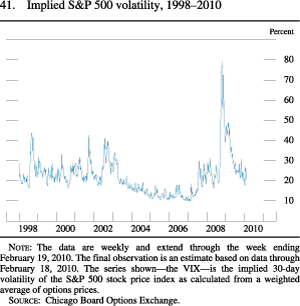
Accessible Version of Figure 41
Banking Institutions
The profitability of the commercial banking sector, as measured by the return on equity, continued to be quite low during the second half of 2009 (figure 42). Elevated loan loss provisioning continued to be the largest factor restraining earnings; however, provisioning decreased significantly in the second half of the year, suggesting that banks believe that credit losses may be stabilizing. While some banks saw earnings boosted earlier last year by gains in trading and investment banking activities, revenue from these sources is reported to have dropped back in the fourth quarter. Although delinquency and charge-off rates for residential mortgages and commercial real estate loans continued to climb in the second half of 2009, for most other types of loans these metrics declined or showed signs of leveling out.
During the year, bank holding companies issued substantial amounts of common equity. Significant issuance occurred in the wake of the release of the Supervisory Capital Assessment Program (SCAP) results, which indicated that some firms needed to augment or improve the quality of their capital in order to assure that, even under a macroeconomic scenario that was more adverse than expected, they would emerge from the subsequent two-year period still capable of meeting the needs of creditworthy borrowers. The 19 SCAP firms issued about $110 billion in new common equity; combined with conversions of preferred stock, asset sales, and other capital actions, these steps have added more than $200 billion to common equity since the beginning of 2009. Equity offerings were also undertaken by other financial firms, and some used the proceeds to repay funds received as part of the Capital Purchase Program.
Against a backdrop of weak loan demand and tight credit policies throughout 2009, total loans on banks' books contracted even more sharply in the last two quarters taken together than in the first half of the year (figure 43). Outstanding unused loan commitments to both businesses and households also declined, albeit at a slower pace than in early 2009. The decline in loans was partially offset by an increase in holdings of securities, particularly Treasury securities and agency MBS, and a further rise in balances at the Federal Reserve. On balance, total industry assets declined. The decline in assets combined with an increase in capital to push regulatory capital ratios considerably higher.
The Financial Accounting Standards Board published Statements of Financial Accounting Standards Nos. 166 and 167 (FAS 166 and 167) in June 2009. The new standards modified the basis for determining whether a firm must consolidate securitized assets (as well as the associated liabilities and equity) onto its balance sheet; most banking organizations must implement the standards in the first quarter of 2010. Industry analysts estimate that banking organizations will consolidate approximately $600 billion of additional assets as a result of implementing FAS 166 and 167. A small number of institutions with large securitization programs will be most affected. While the regulatory capital ratios of the affected banking organizations may decrease after implementation of FAS 166 and 167, the ratios of organizations most affected by the accounting change are expected to remain substantially in excess of regulatory minimums. The federal banking agencies recently published a related risk-based capital rule that includes an optional one-year phase-in of certain risk-based capital impacts resulting from implementation of FAS 166 and 167.16
Monetary Policy Expectations and Treasury Rates
In July 2009, market participants had expected the target federal funds rate to be close to the current target range of 0 to 1/4 percent in early 2010, but they had also anticipated that the removal of policy accommodation would be imminent. Over the second half of 2009, however, investors marked down their expectations for the path of the federal funds rate. Quotes on futures contracts imply that, as of mid-February 2010, market participants anticipate that policy will be tightened beginning in the third quarter of 2010, and that the tightening will proceed at a pace slower than was expected last summer. However, uncertainty about the size of term premiums and potential distortions created by the zero lower bound for the federal funds rate continue to make it difficult to obtain a definitive reading on the policy expectations of market participants from futures prices. The downward revision in policy expectations since July likely has reflected incoming economic data pointing to a somewhat weaker trajectory for employment and a lower path for inflation than had been anticipated. Another contributing factor likely was Federal Reserve communications, including the reiteration in the statement released after each meeting of the Federal Open Market Committee that economic conditions are likely to warrant exceptionally low levels of the federal funds rate for an extended period.
Yields on shorter-maturity Treasury securities have edged lower since last summer, consistent with the downward shift in the expected policy path (figure 44). However, yields on longer-maturity nominal Treasury securities have increased slightly, on net, likely in response to generally positive news about the economy and declines in the weight investors had placed on extremely adverse economic outcomes. The gradual tapering and the completion of the Federal Reserve's large-scale asset purchases of Treasury securities in October 2009 appeared to put little upward pressure on Treasury yields.
Yields on Treasury inflation-protected securities (TIPS) declined somewhat in the second half of 2009 and into 2010. The result was an increase in inflation compensation--the difference between comparable-maturity nominal yields and TIPS yields. The increase was concentrated at shorter-maturities and was partly a response to rising prices of oil and other commodities. Inflation compensation at more distant horizons was somewhat volatile and was little changed on net. Inferences about investors' inflation expectations have been more difficult to make since the second half of 2008 because special factors, such as safe-haven demands and an increased preference of investors for liquid assets, appear to have significantly affected the relative demand for nominal and inflation-indexed securities. These special factors began to abate in the first half of 2009 and receded further in the second half of the year, and the resulting changes in nominal and inflation-adjusted yields may have accounted for part of the recent increase in inflation compensation. On net, survey measures of longer-run inflation expectations have remained stable.
Monetary Aggregates and the Federal Reserve's Balance Sheet
After a brisk increase in the first half of the year, the M2 monetary aggregate expanded slowly in the second half of 2009 and in early 2010 (annual growth rate shown in figure 45).17 The rise in the latter part of the year was driven largely by increases in liquid deposits, as interest rates on savings deposits were reduced more slowly than rates on other types of deposits, and households and firms maintained some preference for safe and liquid assets. Outflows from small time deposits and retail money market mutual funds intensified during the second half of 2009, likely because of ongoing declines in the interest rates offered on these products. The currency component of the money stock expanded modestly in the second half of the year. The monetary base--essentially the sum of currency in circulation and the reserve balances of depository institutions held at the Federal Reserve--expanded rapidly for much of the second half of 2009, as the increase in reserve balances resulting from the large-scale asset purchases more than offset the decline caused by reduced usage of the Federal Reserve's credit programs. However, the monetary base increased more slowly toward the end of 2009 and in early 2010 as these purchases were tapered and as use of Federal Reserve liquidity facilities declined.
The nontraditional monetary policy actions taken by the Federal Reserve since the onset of the financial crisis expanded the size of the Federal Reserve's balance sheet considerably during 2008, and it remained very large throughout 2009 and into 2010 (table 1). Total Federal Reserve assets on February 17, 2010, stood at about $2.3 trillion. The compositional shifts that had been under way in the first half of 2009 continued during the remainder of the year. Lending to depository institutions as well as credit extended under special liquidity facilities and the temporary liquidity swaps with foreign central banks contracted sharply. By contrast, the large-scale asset purchases conducted by the Federal Reserve boosted securities held outright. Holdings of agency MBS surpassed $1 trillion early this year, up from about $525 billion in mid-July 2009. For other types of securities, the increases were more modest, with holdings of agency debt expanding from about $100 billion in July 2009 to $165 billion in February and holdings of Treasury securities rising from nearly $700 billion to approximately $775 billion over the same period. The revolving credit provided to American International Group, Inc. (AIG), declined near year-end, as the outstanding balance was reduced in exchange for preferred interests in AIA Aurora LLC and ALICO Holdings LLC, which are life insurance holding company subsidiaries of AIG. Loans related to the Maiden Lane facilities--which represent credit extended in conjunction with efforts to avoid disorderly failures of The Bear Stearns Companies, Inc., and AIG--stayed roughly steady. On the liability side of the Federal Reserve's balance sheet, reserve balances increased from slightly more than $800 billion in July to about $1.2 trillion as of February 17, 2010, while the Treasury's supplementary financing account fell to $5 billion; the decline in the supplementary financing account occurred late in 2009 as part of the Treasury's efforts to retain flexibility in debt management as federal debt approached the debt ceiling.
1. Selected components of the Federal Reserve balance sheet, 2008-10 (Millions of dollars)
| Balance sheet item | Dec. 31, 2008 | July 15, 2009 | Feb. 17, 2010 |
|---|---|---|---|
| Total assets | 2,240,946 | 2,074,822 | 2,280,952 |
| Selected assets | |||
| Credit extended to depository institutions and dealers | |||
| Primary credit | 93,769 | 34,743 | 14,156 |
| Term auction credit | 450,219 | 273,691 | 15,426 |
| Central bank liquidity swaps | 553,728 | 111,641 | 0 |
| Primary Dealer Credit Facility and other broker-dealer credit | 37,404 | 0 | 0 |
| Credit extended to other market participants | |||
| Asset-Backed Commercial Paper Money Market Mutual Fund Liquidity Facility | 23,765 | 5,469 | 0 |
| Net portfolio holdings of Commercial Paper Funding Facility LLC | 334,102 | 111,053 | 7,721 |
| Net portfolio holdings of LLCs funded through the Money Market Investor Funding Facility | 0 | 0 | 0 |
| Term Asset-Backed Securities Loan Facility | … | 30,121 | 47,182 |
| Support of critical institutions | |||
| Net portfolio holdings of Maiden Lane LLC, Maiden Lane II LLC, and Maiden Lane III LLC1 | 73,925 | 60,546 | 65,089 |
| Credit extended to American International Group, Inc. | 38,914 | 42,871 | 25,535 |
| Preferred interests in AIA Aurora LLC and ALICO Holdings LLC | … | … | 25,106 |
| Securities held outright | |||
| U.S. Treasury securities | 475,921 | 684,030 | 776,571 |
| Agency debt securities | 19,708 | 101,701 | 165,587 |
| Agency mortgage-backed securities (MBS)2 | … | 526,418 | 1,025,541 |
| MEMO | |||
| Term Securities Lending Facility3 | 171,600 | 4,250 | 0 |
| Total liabilities | 2,198,794 | 2,025,348 | 2,228,425 |
| Selected liabilities | |||
| Federal Reserve notes in circulation | 853,168 | 870,327 | 892,985 |
| Reserve balances of depository institutions | 860,000 | 808,824 | 1,205,165 |
| U.S. Treasury, general account | 106,123 | 65,234 | 49,702 |
| U.S. Treasury, supplemental financing account | 259,325 | 199,939 | 5,000 |
| Total capital | 42,152 | 49,474 | 52,527 |
Note: LLC is a limited liability company.
1. The Federal Reserve has extended credit to several LLCs in conjunction with efforts to support critical institutions. Maiden Lane LLC was formed to acquire certain assets of The Bear Stearns Companies, Inc. Maiden Lane II LLC was formed to purchase residential mortgage-backed securities from the U.S. securities lending reinvestment portfolio of subsidiaries of American International Group, Inc. (AIG). Maiden Lane III LLC was formed to purchase multisector collateralized debt obligations on which the Financial Products group of AIG had written credit default swap contracts. Return to table
2. Includes only MBS purchases that have already settled. Return to table
3. The Federal Reserve retained ownership of securities lent through the Term Securities Lending Facility. Return to table
... Not applicable. Return to table
Source: Federal Reserve Board.
International Developments
International Financial Markets
Global financial markets recovered considerably in 2009 as the effectiveness of central bank and government actions in stabilizing the financial system became more apparent and as signs of economic recovery began to take hold. Stock markets in the advanced foreign economies registered gains of about 50 percent from their troughs in early March, although they remain below their levels at the start of the financial crisis in August 2007 (figure 46). Stock markets in the emerging market economies rebounded even more impressively over the year. Most Latin American and many emerging Asian stock markets are now close to their levels at the start of the crisis (figure 47).
As global prospects improved, investors shifted away from the safe-haven investments in U.S. securities they had made at the height of the crisis. As a result, the dollar, which had appreciated sharply in late 2008, depreciated against most other currencies in the second and third quarters of 2009. The dollar depreciated particularly sharply against the currencies of major commodity-producing nations, such as Australia and Brazil, as rising commodity prices supported economic recovery in those countries. In the fourth quarter, the dollar stabilized and has since appreciated somewhat, on net, as investors began to focus more on economic news and prospects for the relative strength of the economic recoveries in the United States and elsewhere (figure 48). Chinese authorities held the renminbi steady against the dollar throughout the year. For 2009 as a whole, the dollar depreciated roughly 4-1/2 percent on a trade-weighted basis against the major foreign currencies (figure 49) and 3-1/2 percent against the currencies of the other important trading partners of the United States.
Sovereign bond yields in the advanced economies rose over most of 2009 as investors moved out of safe investments in government securities and became more willing to purchase riskier securities. Concerns about rising budget deficits in many countries and the associated borrowing needs also likely contributed to the increase in yields. Late in the year, the announcement of a substantial upward revision to the budget deficit in Greece led to a sharp rise in spreads of Greece's sovereign debt over comparable yields on Germany's sovereign debt. These spreads remained elevated in early 2010 and also increased in other euro-area countries with sizable budget deficits, especially Portugal and Spain. Sovereign yields in most of the advanced economies, however, remained significantly lower than prior to the financial crisis, as contained inflation, expectations of only slow economic recovery, and easing of monetary policy by central banks have all worked to keep long-term nominal interest rates low (figure 50).
Conditions in global money markets have continued to improve. One-month Libor-OIS spreads in euros and sterling are now less than 10 basis points, near their levels before the crisis. Dollar funding pressures abroad have also substantially abated, and foreign firms are more easily able to obtain dollar funding through private markets such as those for foreign exchange swaps. As a result, drawings on the Federal Reserve's temporary liquidity swap lines by foreign central banks declined in the second half of 2009 to only about $10 billion by the end of the year, and funding markets continued to function without disruption as these swap lines expired on February 1, 2010.
The Financial Account
The pattern of financial flows between the United States and the rest of the world in 2009 reflected the recovery under way in global markets. As the financial crisis eased, net bank lending abroad resumed, but the recovery in portfolio flows was mixed.
Total private financial flows reversed from the large net inflows that had characterized the second half of 2008 to large net outflows in the first half of 2009 (figure 51). This reversal primarily reflected changes in net bank lending. Banks located in the United States had sharply curtailed their lending abroad as the financial crisis intensified in the third and fourth quarters of 2008, and they renewed their net lending as functioning of interbank markets improved in the first half of 2009. During the second half of 2009, interbank market conditions continued to normalize, and net bank lending proceeded at a moderate pace. The increased availability of funding in private markets also led to reduced demand from foreign central banks for drawings on the liquidity swap lines with the Federal Reserve. Repayment of the drawings in the first half of 2009 generated sizable U.S. official inflows that offset the large private banking outflows.
Foreign official institutions continued purchasing U.S. Treasury securities at a strong pace throughout 2009, as they had during most of the crisis (figure 52). Foreign exchange intervention by several countries to counteract upward pressure on their currencies gave a boost to these purchases. Countries conducting such intervention bought U.S. dollars in foreign currency markets and acquired U.S. assets, primarily Treasury securities, with the proceeds.
During the height of the crisis, private foreign investors had also purchased record amounts of U.S. Treasury securities, likely reflecting safe-haven demands. Starting in April 2009, as improvement in financial conditions became more apparent, private foreigners began to sell U.S. Treasury securities, but net sales in the second and third quarters were modest compared with the amounts acquired in previous quarters. The recovery in foreign demand for riskier U.S. securities was mixed. Foreign investment in U.S. equities picked up briskly after the first quarter of 2009, nearly reaching a pre-crisis pace. However, foreign investors continued small net sales of U.S. corporate and agency debt. Meanwhile, U.S. investment in foreign securities bounced back quickly and remained strong throughout 2009 (figure 53).
Advanced Foreign Economies
Economic activity in the advanced foreign economies continued to fall sharply in early 2009 but began to recover later in the year as financial conditions improved and world trade rebounded. The robust recovery in emerging Asia helped the Japanese economy to turn up in the second quarter, and other major foreign economies returned to positive economic growth in the second half. Nevertheless, performance has been mixed. Spurred by external demand and a reduction in the pace of inventory destocking, industrial production has risen in most countries but remains well below pre-crisis levels. Business confidence has shown considerable improvement, and survey measures of manufacturing activity have risen as well. Consumer confidence also has improved as financial markets have stabilized, but household finances remain stressed, with unemployment at high levels and wage gains subdued. Although government incentives helped motor vehicle purchases to bounce back from the slump in early 2009, other household spending has remained sluggish in most countries. Housing prices have recovered somewhat in the United Kingdom and more in Canada but have continued to decline in Japan and in some euro-area countries.
Twelve-month consumer price inflation moved lower through the summer, with headline inflation turning negative in all the major advanced foreign countries except the United Kingdom. However, higher energy prices in the second half of 2009 pushed inflation back into positive territory except in Japan (figure 54). Core consumer price inflation, which excludes food and energy, has fluctuated less.
Foreign central banks cut policy rates aggressively during the first half of 2009 and left those rates at historically low levels through year-end (figure 55). The European Central Bank (ECB) has held its main policy rate at 1 percent since May and has made significant amounts of long-term funding available at this rate, allowing overnight interest rates to fall to around 0.35 percent. The Bank of Canada has indicated that it expects to keep its target for the overnight rate at a record low 0.25 percent until at least mid-2010. In addition to their interest rate moves, foreign central banks pursued unconventional monetary easing. The Bank of England continued its purchases of British treasury securities, increasing its Asset Purchase Facility from £50 billion to £200 billion over the course of the year. Amid concerns about persistent deflation, the Bank of Japan announced a new ¥10 trillion three-month secured lending facility at an unscheduled meeting on December 1. The ECB has continued its planned purchases of up to €60 billion in covered bonds, but it has also taken some initial steps toward scaling back its enhanced credit support measures, as it sees reduced need for special programs to provide liquidity.
Emerging Market Economies
Recovery from the global financial crisis has been more pronounced in the emerging market economies than in the advanced foreign economies. In aggregate, emerging market economies continued to contract in the first quarter of 2009, but economic activity in many countries, particularly in emerging Asia, rebounded sharply in the second quarter and remained robust in the second half of the year. The upturn in economic activity was driven largely by domestic demand, which received strong boosts from monetary and fiscal stimulus. By the end of 2009, the level of real GDP in several emerging market economies had recovered to or was approaching pre-crisis peaks. With significant spare capacity as a result of the earlier steep contraction in activity in these economies, inflation remained generally subdued through the first half of last year but moved up in the fourth quarter as adverse weather conditions led to a sharp rise in food prices.
In China, the fiscal stimulus package enacted in November 2008, combined with a surge in bank lending, led to a sharp rise in investment and consumption. Strong domestic demand contributed to a rebound in imports, which helped support economic activity in the rest of Asia and in commodity-exporting countries. Chinese authorities halted the modest appreciation of their currency against the dollar in the middle of 2008, and the exchange rate between the renminbi and the dollar has been unchanged since then. In the second half of 2009, authorities acted to slow the increase in bank lending to a more sustainable pace after the level of outstanding loans rose in the first half of the year by nearly one-fourth of nominal GDP. With the economy booming and inflation picking up, the People's Bank of China (the central bank) increased the required reserve ratio for banks 1/2 percentage point in January 2010 and again in February, the country's first significant monetary policy tightening moves since the financial crisis. In China and elsewhere in Asia, asset prices have rebounded sharply after falling steeply in the second half of 2008.
In Latin America, the rebound in activity has lagged that in Asia. Economic activity in Mexico, which is more closely tied to U.S. production and was adversely affected by the outbreak of the H1N1 virus last spring, did not turn up until the third quarter of 2009, but it then grew rapidly. In Brazil, the recession was less severe than in Mexico, and economic growth has been fairly strong since the second quarter of last year, supported in part by government stimulus and rising commodity prices.
Russia and many countries in emerging Europe suffered severe output contractions in the first half of 2009 and, in some cases, further financial stresses. In particular, Latvia faced difficulties meeting the fiscal conditions of its international assistance package, which heightened concerns about the survival of the Latvian currency regime. However, economic and financial conditions in emerging Europe began to recover in the second half of the year.
Footnotes
1. Specifically, the Primary Dealer Credit Facility, the Term Securities Lending Facility, the Commercial Paper Funding Facility, the Asset-Backed Commercial Paper Money Market Mutual Fund Liquidity Facility, and the temporary swap lines with foreign central banks were closed. Return to text
2. The first-time homebuyer tax credit, which was enacted in February 2009 as part of the American Recovery and Reinvestment Act, was originally scheduled to expire on November 30, 2009. In early November, however, the Congress extended the credit to sales occurring through April 30, 2010, and expanded it to include repeat homebuyers who have owned and occupied a house for at least five of the past eight years. Return to text
3. The survey, formerly the Reuters/University of Michigan Surveys of Consumers, was renamed the Thomson Reuters/University of Michigan Surveys of Consumers as of January 1, 2010. Return to text
4. A mortgage is defined as seriously delinquent if the borrower is 90 days or more behind in payments or the property is in foreclosure. Return to text
5. Conforming mortgages are those eligible for purchase by Fannie Mae and Freddie Mac; they must be equivalent in risk to a prime mortgage with an 80 percent loan-to-value ratio, and they cannot exceed in size the conforming loan limit. The conforming loan limit for a first mortgage on a single-family home in the contiguous United States is currently equal to the greater of $417,000 or 115 percent of the area's median house price, and it cannot exceed $729,750. Return to text
6. Sales dropped back in January, but the decline occurred largely at Toyota, which was confronted by widely publicized problems. Return to text
7. The increases in benefit payments under the American Recovery and Reinvestment Act included an expansion of unemployment benefits, increases in food stamps and Pell grants, subsidies for health insurance coverage for the unemployed, and a one-time $250 payment to retirees and veterans. Return to text
8. The Credit CARD Act includes some provisions that place restrictions on issuers' ability to impose certain fees and to engage in risk-based pricing. Some provisions took effect in August 2009, and others did so in February 2010. Return to text
9. This statement updated and replaced existing supervisory guidance to assist examiners in evaluating institutions' efforts to renew or restructure loans to creditworthy CRE borrowers. The statement was intended to promote supervisory consistency, enhance the transparency of CRE workout transactions (that is, transactions intended to renew and restructure the loans), and ensure that supervisory policies and actions do not inadvertently curtail the availability of credit to sound borrowers. For more information, see Board of Governors of the Federal Reserve System, Federal Deposit Insurance Corporation, National Credit Union Administration, Office of the Comptroller of the Currency, Office of Thrift Supervision, and Federal Financial Institutions Examination Council State Liaison Committee (2009), "Policy Statement on Prudent Commercial Real Estate Loan Workouts," attachment to Supervision and Regulation Letter SR 09-7 (October 30), www.federalreserve.gov/boarddocs/srletters/2009/sr0907a1.pdf. Return to text
10. For more information, see Federal Deposit Insurance Corporation, Office of the Comptroller of the Currency, Board of Governors of the Federal Reserve System, the Office of Thrift Supervision, National Credit Union Administration, and Conference of State Bank Supervisors (2010), "Interagency Statement on Meeting the Credit Needs of Creditworthy Small Business Borrowers," attachment to "Regulators Issue Statement on Lending to Creditworthy Small Businesses," joint press release, February 5, www.occ.treas.gov/ftp/release/2010-14.htm. Return to text
11. Because final payments on 2008 liabilities were not due until April of 2009 and because of the difference between fiscal and calendar years, much of the contraction in 2008 corporate profits did not show through to tax revenues until fiscal 2009. Return to text
12. In the Monthly Treasury Statements, equity purchases and debt-related transactions under the TARP are recorded on a net present value basis, taking into account market risk, as are the Treasury's purchases of the GSE's MBS. However, equity purchases from the GSEs in conservatorship are recorded on a cash flow basis. Return to text
13. Consumption expenditures by state and local governments include all outlays other than those associated with investment projects. Return to text
14. The Build America Bonds program allows state and local governments to issue taxable bonds for capital projects and receive a subsidy payment from the Treasury for 35 percent of interest costs. Return to text
15. Variable-rate demand obligations (VRDOs) are taxable or tax-exempt bonds that combine long maturities with floating short-term interest rates that are reset on a weekly, monthly, or other periodic basis. VRDOs also have a contractual liquidity backstop, typically provided by a commercial or investment bank, that ensures that bondholders are able to redeem their investment at par plus accrued interest even if the securities cannot be successfully remarketed to other investors. Return to text
16. For more information and the text of the final rule, see Office of the Comptroller of the Currency, Board of Governors of the Federal Reserve System, Federal Deposit Insurance Corporation, and Office of Thrift Supervision (2010), "Agencies Issue Final Rule for Regulatory Capital Standards Related to Statements of Financial Accounting Standards Nos. 166 and 167," press release, January 21, www.federalreserve.gov/newsevents/press/bcreg/20100121a.htm. The final rule was also published in the Federal Register; see Office of the Comptroller of the Currency, Board of Governors of the Federal Reserve System, Federal Deposit Insurance Corporation, and Office of Thrift Supervision (2010), "Risk-Based Capital Guidelines; Capital Adequacy Guidelines; Capital Maintenance: Regulatory Capital; Impact of Modifications to Generally Accepted Accounting Principles; Consolidation of Asset-Backed Commercial Paper Programs; and Other Related Issues," final rule, Federal Register, vol. 75 (January 28), pp. 4636–54. Return to text
17. M2 consists of (1) currency outside the U.S. Treasury, Federal Reserve Banks, and the vaults of depository institutions; (2) traveler's checks of nonbank issuers; (3) demand deposits at commercial banks (excluding those amounts held by depository institutions, the U.S. government, and foreign banks and official institutions) less cash items in the process of collection and Federal Reserve float; (4) other checkable deposits (negotiable order of withdrawal, or NOW, accounts and automatic transfer service accounts at depository institutions; credit union share draft accounts; and demand deposits at thrift institutions); (5) savings deposits (including money market deposit accounts); (6) small-denomination time deposits (time deposits issued in amounts of less than $100,000) less individual retirement account (IRA) and Keogh balances at depository institutions; and (7) balances in retail money market mutual funds less IRA and Keogh balances at money market mutual funds. Return to text

